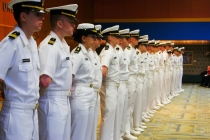The NROTC Today
In today's world the young men and women are joining the NROTC program for many different reasons. Though some still join to continue the traditions set down by their parents or relatives, a "new breed" has evolved to make the ranks of today's military. Unhindered by external pressures to join the armed forces, young people are joining today for three fundamental reasons. The first, as it has always been, is still a sense of accomplishment and pride which comes from being part of the Naval and Marine Corps team. The second reason is partly a byproduct of the society we live in, in that young men and women are using their Navy commitments as a bridge to gain critical experience and skills necessary in the civilian sector. It has been shown in recent years though, that specifically within the aviation community the turnover rate is deplorable and much needed senior experience is lost to a higher paying civilian job market. Finally, another byproduct of today's society is the need for a college education, and one's ability to get one readily and relatively quickly. The days of earning a high-school diploma to be competitive are over, and filling out a scholarship form to go to college for free with a relatively free and guaranteed job afterwards is often a plus for young people.
Although the United States Navy and Marine Corps may be different institutions compared to the ones that Alfred Thayer Mahan wrote about in 1898, in many regards they are the same. Likewise, the Villanova NROTC program has undergone changes both subtle and radical, both internal and external, but in many ways it is still training the same high-caliber midshipmen. The ultimate goal has never changed: to train young people to become successful Naval and Marine Corps officers, but the evolutions of completing this task have. No longer is it necessary to learn the hands-on specifics of ship-life, and no longer is it imperative to be transformed into the perfect gentleman. The emphasis is now concerned more with intangibles such as leadership, morality, and a sense of the Navy's core values- Honor, Courage, and Commitment.
The society and the Navy that supports the NROTC program has also changed. With the usage of the "do more with less", "Right-sizing" and "Total Quality Management" catch-phrases the Navy and Marine Corps have become the most situationally and technologically aware that they have ever been. Society too has played a major role in shaping today’s military. The Navy of old was a middle and upper-class men's club, with a social structure and camaraderie that was very influenced from the period. The Navy of the 1990s has obviously shifted from those concepts, making it even more important to impress upon young people the values that make a proficient Navy and Marine Corps, especially in light of such tragic events as the Tailhook scandal and the CNO's death. These conflicts, foreign to a midshipman who went through the program in the early stages, are what today's students must deal with on a day-to-day basis. But the same is still true when compared to other institutions of NROTC: that regardless of the time period, the Villanovan experience with the Navy and the Marine Corps can and will continue to produce the same high-caliber officers as it has always done.

